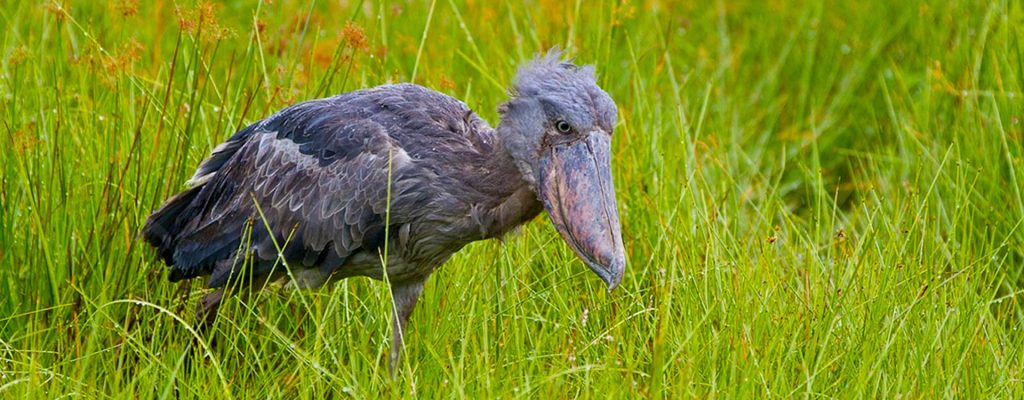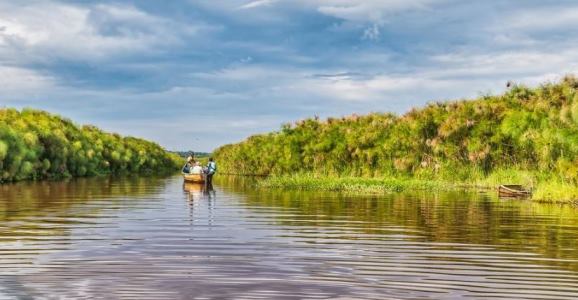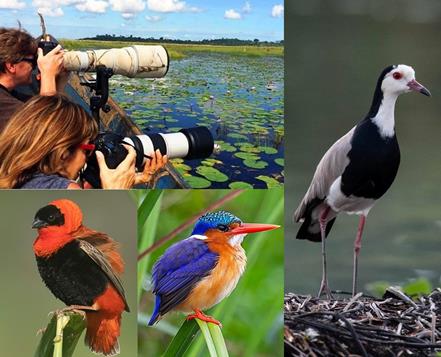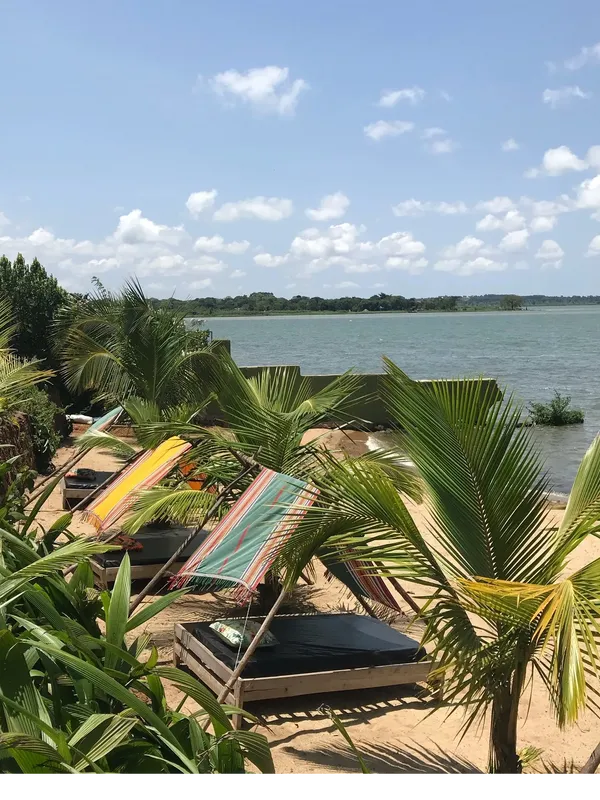Mabamba Swamp – Premier Destination for Shoebill Spotting in Uganda
 Mabamba Swamp Shoebill Bird Watching: Best Place for Sighting the Shoebill in Uganda
Mabamba Swamp Shoebill Bird Watching: Best Place for Sighting the Shoebill in Uganda
Explore the Unique Ecosystem of Mabamba Swamp
Situated just a short distance from Entebbe and nestled on the shores of Lake Victoria, 50 kilometers west of Kampala, Mabamba Swamp emerges as a premier destination for witnessing the majestic Shoebill Stork in Uganda. This vast wetland, easily accessible for either a fulfilling day trip or an extended safari adventure, is a marvel of natural beauty and mystery. With its intricate network of marshy channels, Mabamba Swamp not only stands out as one of the world’s most extraordinary places to see the elusive Shoebill but also offers a unique and unforgettable birding experience unrivaled in Uganda.
The Elusive and Ancient-Looking Shoebill of Uganda
A Glimpse into the World of the Shoebill (Balaeniceps rex)
In the heart of Uganda and across East Africa lies the home of a truly unique avian species, the Shoebill (Balaeniceps rex). This bird, often described as prehistoric in appearance, captivates birdwatchers and nature enthusiasts alike. Below is a detailed exploration of the Shoebill’s characteristics and habitat.
Distinctive Appearance of the Shoebill
- Size and Stature: The Shoebill stands out with its impressive size, measuring approximately 4 to 5 feet (1.2 to 1.5 meters) in height with a wingspan stretching 7 to 8 feet (2.1 to 2.4 meters). Its robust build, thick neck, and sturdy legs are perfectly adapted to its wetland environment.
- Remarkable Bill: The Shoebill’s most striking feature is its large, shoe-shaped bill. This greyish, flattened bill with a sharp, hooked tip can reach up to 9.8 inches (25 centimeters) in length, making it one of the most distinctive bills in the bird kingdom.
- Plumage: Its bluish-gray plumage, occasionally showing hints of green, helps the Shoebill blend seamlessly into its swampy habitat. The shorter feathers on its head lend a somewhat fuzzy appearance.
- Head and Eyes: The Shoebill’s large, rounded head is topped with a thick, dark crest. Its yellow eyes, encircled by a bare patch of skin that changes color based on mood or breeding season, add to its intriguing look.
Habitat and Behavior
- Natural Habitat: Predominantly found in freshwater swamps, marshes, and wetlands adorned with tall grasses and papyrus reeds, the Shoebill thrives in areas abundant with fish, frogs, and other aquatic prey, like lungfish.
- Hunting Techniques: Known for their patience, Shoebills exhibit a remarkable hunting strategy. They can stand motionless for extended periods in shallow waters, striking swiftly and powerfully when prey comes within reach.
A Birdwatcher’s Paradise
Apart from the Shoebill, Mabamba Swamp teems with a variety of bird species. It’s a sanctuary for birds like the African Jacana, known for its long toes, the vibrant Malachite Kingfisher, the Yellow-billed Duck, the elegant Purple Heron, the majestic African Fish Eagle, and the White-faced Whistling Duck. Each species contributes to the rich biodiversity of this wetland.
Discover the Diverse Wildlife
Mabamba Swamp is also home to an array of other wildlife. You might spot the sitatunga antelope, several species of playful otters, impressive monitor lizards, and vervet monkeys with their distinctive blue faces and tails.
Best Times for Wildlife Viewing
To maximize your wildlife encounters, visit the swamp early in the morning or in the late afternoon. This is when the Shoebill and other bird species are most active, feeding and calling. For other wildlife like sitatunga and otters, these times also increase your chances of sightings.
A Serene Boat Tour Experience
Embark on a guided boat tour to explore the tranquil waterways of Mabamba Swamp. These tours not only offer the chance to spot the Shoebill but also allow you to immerse yourself in the peaceful scenery, surrounded by the sounds of nature.
Stay at the Serene Mabamba Lodge
For a complete experience, stay at Mabamba Lodge. Nestled on the shores of Lake Victoria, the lodge offers rustic yet comfortable cottages and tents, alongside activities like birdwatching and canoeing, all within a sustainable tourism framework.
- Accommodations: Guests can enjoy their stay in well-appointed cottages and tents, each featuring a private bathroom, comfortable bedding, and a private veranda or balcony with scenic views. The decor, characterized by locally sourced materials and traditional African art, adds to the authentic ambiance.
- Activities and Wildlife Exploration: Mabamba Lodge offers a variety of activities, including birdwatching, fishing, canoeing, and guided walks. Experienced guides are available to help guests spot the Shoebill and other wildlife, enhancing the safari experience.
- Dining Experience: The lodge boasts a restaurant serving a selection of local and international dishes, emphasizing fresh, locally sourced ingredients. Guests can savor their meals in a cozy dining room or on an outdoor terrace with views of Lake Victoria.

- Commitment to Sustainability: Mabamba Lodge is dedicated to sustainable tourism and community development. Collaborating with local communities, the lodge provides employment opportunities and supports conservation and educational programs, making it an ideal choice for eco-conscious travelers.
Conservation Status and Other Places to See the Shoebill in Uganda
The Shoebill is currently classified as “Vulnerable” by the International Union for Conservation of Nature (IUCN). This status is due to factors like habitat loss, degradation, and hunting pressures. Uganda’s vast wetlands and protected areas, such as national parks, are crucial for the Shoebill’s survival.
In addition to Mabamba Swamp, Uganda boasts several other locations for spotting Shoebills:
- Murchison Falls National Park: Known for its diverse wildlife and the magnificent Murchison Falls, it’s a great place to spot Shoebills along the marshy Nile Delta.
- Queen Elizabeth National Park: This park offers a chance to see Shoebills in the swamps at Lake George’s end.
- Semliki National Park: Located in Western Uganda, it is renowned for its tropical rainforest and wetland areas, making it an ideal habitat for Shoebills.
- Ziwa Rhino and Wildlife Ranch: While primarily a rhino conservation area, it also provides opportunities to observe Shoebills in its Luggogo Swamp.
Responsible Wildlife Viewing Practices
When observing the Shoebill and other species, it’s vital to practice responsible wildlife viewing. This ensures the preservation of these magnificent creatures and their habitats for future generations.
Plan Your Safari Adventure
If you have a free day in Entebbe, you should absolutely do a Mabamba swamp tour. Contact us to arrange your safari in Uganda, renowned as the best place to see Shoebill in Uganda. Discover its diverse wildlife and unique birdwatching opportunities in this serene wetland paradise, ensuring memories that will last a lifetime.
You might find the following links helpful to explore:
- 12-Day Uganda Gorilla-Chimpanzee and Wildlife Safari
- 16 Days of Ugandan Wonders: Gorilla-Chimpanzee Trekking & Wildlife Discoveries
